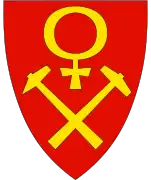Røros Municipality
Røros kommune Rossen tjïelte | |
|---|---|
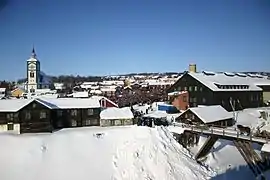 View of the mining town of Røros | |
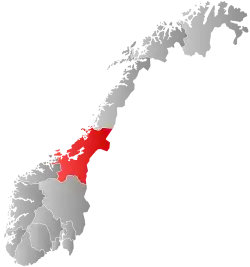 Trøndelag within Norway | |
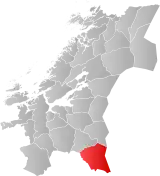 Røros within Trøndelag | |
| Coordinates: 62°34′27″N 11°22′59″E / 62.57417°N 11.38306°E | |
| Country | Norway |
| County | Trøndelag |
| District | Gauldal |
| Established | 1 Jan 1838 |
| • Created as | Formannskapsdistrikt |
| Disestablished | 1 Jan 1926 |
| • Succeeded by | Røros bergstad, Røros landsogn, Brekken, Glåmos |
| Re-established | 1 Jan 1964 |
| • Preceded by | Røros bergstad, Røros landsogn, Brekken, Glåmos |
| Administrative centre | Røros |
| Government | |
| • Mayor (2019) | Isak Veierud Busch (Ap) |
| Area | |
| • Total | 1,956.55 km2 (755.43 sq mi) |
| • Land | 1,756.45 km2 (678.17 sq mi) |
| • Water | 200.10 km2 (77.26 sq mi) 10.2% |
| • Rank | #39 in Norway |
| Population (2023) | |
| • Total | 5,598 |
| • Rank | #167 in Norway |
| • Density | 3.2/km2 (8/sq mi) |
| • Change (10 years) | |
| Demonym | Rørosing[1] |
| Official language | |
| • Norwegian form | Neutral |
| Time zone | UTC+01:00 (CET) |
| • Summer (DST) | UTC+02:00 (CEST) |
| ISO 3166 code | NO-5025[3] |
| Website | Official website |
 The old Røros in front of the church | |
| Official name | Røros Mining Town and the Circumference |
| Criteria | Cultural: iii, iv, v |
| Reference | 55 |
| Inscription | 1980 (4th Session) |
| Extensions | 2010 |
| Area | 16,510 ha (64 sq mi) |
| Buffer zone | 481,240 ha (1,858 sq mi) |
ⓘ (Norwegian) or Rosse (Southern Sami)[4] is a municipality in Trøndelag county, Norway. The administrative centre of the municipality is the town of Røros. Some of the villages in Røros include Brekken, Glåmos, Feragen, Galåa, and Hitterdalen.
The mining town of Røros (the administrative centre of the municipality) is sometimes called Bergstaden which means "mountain town" due to its historical renown for copper mining. It is one of two towns in Norway that were historically designated "mining towns", along with the "silver-town" of Kongsberg. The modern-day inhabitants of Røros still work and live in the characteristic 17th and 18th century buildings which led to its designation as a UNESCO World Heritage Site in 1980. Røros has about 80 wooden houses, most of them standing around courtyards. Many retain their dark pitch-log facades, giving the town a medieval appearance.[5]
The 1,957-square-kilometre (756 sq mi) municipality is the 39th largest by area out of the 356 municipalities in Norway. Røros is the 167th most populous municipality in Norway with a population of 5,598. The municipality's population density is 3.2 inhabitants per square kilometre (8.3/sq mi) and its population has increased by 0.2% over the previous 10-year period.[6][7]
General information
The parish of Røros was established as a municipality on 1 January 1838 (see formannskapsdistrikt law). On 1 January 1875, an unpopulated area of the neighbouring municipality of Ålen was transferred to Røros. On 1 January 1926, Røros was split into four municipalities: Røros landsogn (population: 701), Brekken (population: 1,098), Glåmos (population: 983), and the town of Røros (population: 2,284). During the 1960s, there were many municipal mergers across Norway due to the work of the Schei Committee. On 1 January 1964, the four municipalities of Glåmos (population: 700), Brekken (population: 964), Røros landsogn (population: 482), and the town of Røros (population: 3,063) were all reunited under the name Røros. On 21 April 1989, an unpopulated part of Røros was transferred to the neighbouring Holtålen municipality.[8] On 1 January 2018, the municipality switched from the old Sør-Trøndelag county to the new Trøndelag county.
Name
The municipality (originally the parish and town) is named after the old Røros farm (Old Norse: Røyðaróss) since this was the site of the mining town of Røros. The first element comes from the local river name Røa (Røyðr) which has an unknown meaning. The last element comes from óss which means "mouth of a river" (the small river Røa runs into the great river Glåma here).[9]
On 9 September 2022, the national government approved a resolution to add a co-equal, official Sami language name for the municipality: Rosse.[10] The spelling of the Sami language name changes depending on how it is used. It is called Rosse when it is spelled alone, but it is Rossen tjïelte when using the Sami language equivalent to "Røros municipality".[4]
Coat of arms
The coat of arms was granted on 29 October 1992. The blazon is "Gules, a venus symbol over a crossed hammer and chisel Or" (Norwegian: I rødt, en gull kobber (venus-symbol) over korslagt bergjarn og feisel). This means the arms have a red field (background) and the charge is a venus symbol over a crossed hammer and chisel. The charge has a tincture of Or which means it is commonly colored yellow, but if it is made out of metal, then gold is used. The design symbolizes the copper mining industry in Røros. The venus symbol is the old symbol for copper, which was heavily mined in Røros for centuries. The arms were designed by Sverre Ødegaard. The municipal flag has the same design as the coat of arms.[11][12][13]
Churches
The Church of Norway has four parishes (sokn) within the municipality of Røros. It is part of the Gauldal prosti (deanery) in the Diocese of Nidaros.
| Parish (sokn) | Church name | Location of the church | Year built |
|---|---|---|---|
| Røros | Røros Church | Røros | 1784 |
| Røros Chapel | Røros | 1962 | |
| Brekken | Brekken Church | Brekken | 1878 |
| Glåmos | Glåmos Church | Glåmos | 1926 |
| Hitterdalen | Hitterdal Chapel | Hitterdalen | 1959 |
History
Røros municipality has historically been used by the Southern Sami people for reindeer herding. Known for its copper mines, Røros is one of Norway's two nationally significant mining towns with activity starting in the 17th century (the other one being the "silver-town" Kongsberg, see Kongsberg Silver Mines).
Røros was burned to the ground in 1678 and 1679 by the Swedish Army during the Scanian War. In 1718, during the Great Northern War, the town was once again taken by the Swedish Army, led by General De la Barre, who made up the southern arm of the main Swedish Army under Carl Gustaf Armfeldt. De la Barre took the city and all their mined copper at gunpoint.
When King Carl XII was killed near Fredriksten on 30 November 1718, De la Barre retreated north to join the bulk of the army. However, this ended in tragedy, when over 3,000 rather unprepared soldiers perished in the harsh weather conditions in the mountains northwest of Røros.
Røros and its people were made famous to Norwegians at the turn of the 20th century by semi-fictional author Johan Falkberget, who told the story of the mining community from the perspective of the hard-tested miners at the bottom of the social ladder.
With its authentic wooden buildings, Røros was added to the UNESCO World Heritage Site list in 1980.[14]
Røros Copper Works
In 1644, the general manager of the mine at Kongsberg gave permission to exploit one lode of copper in the mountains near Rauhaammaaren. Storvola and Gamle Storwartz became some of the company's most important mines. Nordgruve, another important mining area, was situated to the north east of Røros.
In 1685, Røros discovered a considerable amount of associated silver mines. The mining activity lasted for about 40 years, and a total of 1,350 tons of sterling silver was mined. This provided considerable revenue for the Danish-Norwegian treasury to support Frederick IV in building the palace of Solbjerg.
1740 onwards saw a period of greatness for the Røros Copper Works with several mines yielding well. Due to the funding of the Oldenburg royal family, the scale of the Leros silver mine and copper mine expanded. As the mine is close to Trondheim and at a lower latitude, the ore output is much higher than ScandinaviaFalun. The rich income of the mining area also prompted the royal family to repeatedly ask for an expansion of the mining. Dynamite was utilised from 1870 and later drilling machines. The electrical generating station built high-tension power lines to supply the mines, starting in 1897. The Bessemer process was introduced at the end of the 1800s. The Rørosbanen railway line was completed in 1877. High prices for both copper and zinc gave good results, but then the prices dropped and there were several years with large losses. After 333 years, mining activity in Røros ceased in 1977.[15]
Culture
During winter, a traditional market called "Rørosmartnan" is organised, drawing an average 60,000–70,000 tourists to the town of Røros each year. The market begins on the last Tuesday in February and lasts five days.[16] There is also an outdoor musical theatre performance played in Røros to commemorate the tragedy when the Swedish soldiers froze to death. This show has been played since 1994.[17]
The town of Røros was the filming location for Henrik Ibsen's play "A Doll's House", directed by Joseph Losey.[18]
Media
The newspapers Arbeidets Rett and Fjell-Ljom are published in Røros.
Government
Røros Municipality is responsible for primary education (through 10th grade), outpatient health services, senior citizen services, welfare and other social services, zoning, economic development, and municipal roads and utilities. The municipality is governed by a municipal council of directly elected representatives. The mayor is indirectly elected by a vote of the municipal council.[19] The municipality is under the jurisdiction of the Trøndelag District Court and the Frostating Court of Appeal.
Municipal council
The municipal council (Kommunestyre) of Røros is made up of 27 representatives who are elected to four-year terms. The tables below show the current and historical composition of the council by political party.
| Party name (in Norwegian) | Number of representatives | |
|---|---|---|
| Labour Party (Arbeiderpartiet) | 12 | |
| Conservative Party (Høyre) | 5 | |
| Red Party (Rødt) | 1 | |
| Centre Party (Senterpartiet) | 3 | |
| Socialist Left Party (Sosialistisk Venstreparti) | 3 | |
| Liberal Party (Venstre) | 2 | |
| Røros List (Røroslista) | 1 | |
| Total number of members: | 27 | |
| Party name (in Norwegian) | Number of representatives | |
|---|---|---|
| Labour Party (Arbeiderpartiet) | 11 | |
| Conservative Party (Høyre) | 4 | |
| Centre Party (Senterpartiet) | 6 | |
| Socialist Left Party (Sosialistisk Venstreparti) | 4 | |
| Liberal Party (Venstre) | 1 | |
| Røros List (Røroslista) | 1 | |
| Total number of members: | 27 | |
| Party name (in Norwegian) | Number of representatives | |
|---|---|---|
| Labour Party (Arbeiderpartiet) | 11 | |
| Conservative Party (Høyre) | 5 | |
| Centre Party (Senterpartiet) | 3 | |
| Socialist Left Party (Sosialistisk Venstreparti) | 4 | |
| Liberal Party (Venstre) | 2 | |
| Røros List (Røroslista) | 2 | |
| Total number of members: | 27 | |
| Party name (in Norwegian) | Number of representatives | |
|---|---|---|
| Labour Party (Arbeiderpartiet) | 14 | |
| Progress Party (Fremskrittspartiet) | 1 | |
| Conservative Party (Høyre) | 4 | |
| Centre Party (Senterpartiet) | 2 | |
| Socialist Left Party (Sosialistisk Venstreparti) | 3 | |
| Liberal Party (Venstre) | 1 | |
| Røros List (Røroslista) | 2 | |
| Total number of members: | 27 | |
| Party name (in Norwegian) | Number of representatives | |
|---|---|---|
| Labour Party (Arbeiderpartiet) | 12 | |
| Progress Party (Fremskrittspartiet) | 2 | |
| Conservative Party (Høyre) | 4 | |
| Centre Party (Senterpartiet) | 2 | |
| Socialist Left Party (Sosialistisk Venstreparti) | 3 | |
| Liberal Party (Venstre) | 1 | |
| Røros List (Røroslista) | 3 | |
| Total number of members: | 27 | |
| Party name (in Norwegian) | Number of representatives | |
|---|---|---|
| Labour Party (Arbeiderpartiet) | 12 | |
| Progress Party (Fremskrittspartiet) | 2 | |
| Conservative Party (Høyre) | 2 | |
| Pensioners' Party (Pensjonistpartiet) | 1 | |
| Socialist Left Party (Sosialistisk Venstreparti) | 5 | |
| Joint list of the Centre Party (Senterpartiet) and the Liberal Party (Venstre) | 3 | |
| Røros List (Røroslista) | 2 | |
| Total number of members: | 27 | |
| Party name (in Norwegian) | Number of representatives | |
|---|---|---|
| Labour Party (Arbeiderpartiet) | 14 | |
| Conservative Party (Høyre) | 4 | |
| Pensioners' Party (Pensjonistpartiet) | 1 | |
| Socialist Left Party (Sosialistisk Venstreparti) | 2 | |
| Joint list of the Centre Party (Senterpartiet) and the Liberal Party (Venstre) | 3 | |
| Røros List (Røroslista) | 3 | |
| Total number of members: | 27 | |
| Party name (in Norwegian) | Number of representatives | |
|---|---|---|
| Labour Party (Arbeiderpartiet) | 10 | |
| Conservative Party (Høyre) | 2 | |
| Socialist Left Party (Sosialistisk Venstreparti) | 2 | |
| Joint list of the Centre Party (Senterpartiet) and the Liberal Party (Venstre) | 10 | |
| Røros List (Røroslista) | 3 | |
| Total number of members: | 27 | |
| Party name (in Norwegian) | Number of representatives | |
|---|---|---|
| Labour Party (Arbeiderpartiet) | 11 | |
| Conservative Party (Høyre) | 4 | |
| Socialist Left Party (Sosialistisk Venstreparti) | 4 | |
| Joint list of the Centre Party (Senterpartiet) and the Liberal Party (Venstre) | 5 | |
| Cross-party environment list (Tverrpolitisk miljøliste) | 3 | |
| Total number of members: | 27 | |
| Party name (in Norwegian) | Number of representatives | |
|---|---|---|
| Labour Party (Arbeiderpartiet) | 14 | |
| Conservative Party (Høyre) | 5 | |
| Red Electoral Alliance (Rød Valgallianse) | 1 | |
| Socialist Left Party (Sosialistisk Venstreparti) | 3 | |
| Joint list of the Centre Party (Senterpartiet), Christian Democratic Party (Kristelig Folkeparti), and Liberal Party (Venstre) | 4 | |
| Total number of members: | 27 | |
| Party name (in Norwegian) | Number of representatives | |
|---|---|---|
| Labour Party (Arbeiderpartiet) | 16 | |
| Conservative Party (Høyre) | 5 | |
| Red Electoral Alliance (Rød Valgallianse) | 1 | |
| Centre Party (Senterpartiet) | 2 | |
| Socialist Left Party (Sosialistisk Venstreparti) | 2 | |
| Liberal Party (Venstre) | 1 | |
| Total number of members: | 27 | |
| Party name (in Norwegian) | Number of representatives | |
|---|---|---|
| Labour Party (Arbeiderpartiet) | 14 | |
| Conservative Party (Høyre) | 5 | |
| Christian Democratic Party (Kristelig Folkeparti) | 1 | |
| Red Electoral Alliance (Rød Valgallianse) | 1 | |
| Centre Party (Senterpartiet) | 3 | |
| Joint list of the Liberal Party (Venstre) and New People's Party (Nye Folkepartiet) |
2 | |
| Joint list of the Socialist Left Party (Sosialistisk Venstreparti) and the Communist Party (Kommunistiske Parti) | 1 | |
| Total number of members: | 27 | |
| Party name (in Norwegian) | Number of representatives | |
|---|---|---|
| Labour Party (Arbeiderpartiet) | 14 | |
| Conservative Party (Høyre) | 3 | |
| Christian Democratic Party (Kristelig Folkeparti) | 1 | |
| Centre Party (Senterpartiet) | 4 | |
| Socialist Left Party (Sosialistisk Venstreparti) | 3 | |
| Liberal Party (Venstre) | 2 | |
| Total number of members: | 27 | |
| Party name (in Norwegian) | Number of representatives | |
|---|---|---|
| Labour Party (Arbeiderpartiet) | 15 | |
| Conservative Party (Høyre) | 2 | |
| Christian Democratic Party (Kristelig Folkeparti) | 1 | |
| Centre Party (Senterpartiet) | 3 | |
| Liberal Party (Venstre) | 3 | |
| Socialist common list (Venstresosialistiske felleslister) | 3 | |
| Total number of members: | 27 | |
| Party name (in Norwegian) | Number of representatives | |
|---|---|---|
| Labour Party (Arbeiderpartiet) | 16 | |
| Conservative Party (Høyre) | 2 | |
| Communist Party (Kommunistiske Parti) | 1 | |
| Christian Democratic Party (Kristelig Folkeparti) | 1 | |
| Centre Party (Senterpartiet) | 2 | |
| Socialist People's Party (Sosialistisk Folkeparti) | 2 | |
| Liberal Party (Venstre) | 3 | |
| Total number of members: | 27 | |
| Party name (in Norwegian) | Number of representatives | |
|---|---|---|
| Labour Party (Arbeiderpartiet) | 18 | |
| Conservative Party (Høyre) | 3 | |
| Communist Party (Kommunistiske Parti) | 1 | |
| Christian Democratic Party (Kristelig Folkeparti) | 1 | |
| Liberal Party (Venstre) | 2 | |
| Local List(s) (Lokale lister) | 2 | |
| Total number of members: | 27 | |
Mayors
The mayors (Norwegian: ordfører) of Røros:
- 1838–1845: Knud Olsen
- 1846–1847: Peter Ascanius Schult
- 1848–1850: Julius Begtrup
- 1851–1856: Diderik Iversen Tønseth
- 1857–1860: Johannes Berg
- 1861–1882: Diderik Iversen Tønseth (V)
- 1883–1901: Anders Bergan (V)
- 1902–1904: Marius Müller (H)
- 1905–1913: Lars T. Ormhaug (V)
- 1914–1919: Lars Tørres (Ap)
- 1920–1922: Johannes Iv. Ødegaard (Ap)
- 1923–1925: Anders O. Sandkjernan (Bp)
(Municipality was divided into four other municipalities from 1926-1964.)
- 1964–1967: Ole J. Kværneng (Ap)
- 1968–1971: Per A. Strickert (Ap)
- 1972–1973: Rolf Køste (Ap)
- 1973–1975: Per A. Strickert (Ap)
- 1976–1979: Knut W. Larssen (Ap)
- 1980–1987: Erling Sven Busch (Ap)
- 1987-1987: Anders Døhl (Ap)
- 1988-1993: Arne Kokkvoll (Ap)
- 1993-1999: Even Erlien (Sp)
- 1999-2007: John Helge Andersen (Ap)
- 2007-2019: Hans Vintervold (Ap)
- 2019–present: Isak Veierud Busch (Ap)
Geography
Røros is located on a gently sloping plateau about 630 metres (2,070 ft) above sea level that is forested with mostly birch and some pine, but the tree line is never far away. The largest lake within the municipality is Aursund and the river Glåma has its origin here. The most northerly part of Femund, the third largest lake in Norway, is located in Røros, just west of Femundsmarka National Park. These lakes and others in Røros, such as Bolagen and Flensjøen, are well suited for kayaking and fishing. Other lakes include Feragen, Håsjøen, Rambergsjøen, Korssjøen, Nedre Roasten, Rogen, and Rien.
Climate
Røros has a subarctic climate. Mostly sheltered from oceanic influences, and located at ca 650 m amsl, Røros has recorded the coldest temperatures in the southern half of Norway with −50.3 °C (−58.5 °F) in early January 1914. In the European cold snap of January 2010 Røros recorded low of −42 °C (−44 °F). The coldest months recorded are January 1941 and January 1942, both with mean −20.6 °C (−5.1 °F), and average daily low −26.9 °C (−16.4 °F) in January 1941. Winters at Røros are reliably cold. The warmest January (1973) had mean −2.8 °C (27.0 °F), the warmest winter month on record was December 2006 with mean −0.5 °C (31.1 °F), and the warmest March (2012) had mean −0.3 °C (31.5 °F). The heat record 30.7 °C (87.3 °F) was recorded in July 2008. The warmest month on record is July 2014 with mean 16 °C (61 °F), while July 2018 had the warmest average daily high with 23.3 °C (73.9 °F).
Skiing conditions in winter are usually excellent, with the period from February to April being the optimum, as the sun is higher and the days longer than earlier in winter. The deepest snow depth recorded in Røros is 200 centimetres (79 in) in March 1956. In more recent years, 87 centimetres (34 in) snow on the ground was recorded in March 2009. Snow on the ground is virtually guaranteed in Røros from December to early April. Early May 1997 saw 76 cm snow on the ground (source: eklima/met.no).
Haugan, an unincorporated settlement situated 2 kilometres (1.2 mi) from Røros Airport, is the location of a weather station operated by the Norwegian Meteorologist institute. (Norwegian: Meteorologisk institutt).[33]
All the record lows are old, the most recent (December) from 1978, while more than half of the monthly record highs are from year 2000 or later.
| Climate data for Røros (625 m; 1981 - 2010; precipitation days 1961-90, extremes 1900 - 2018) | |||||||||||||
|---|---|---|---|---|---|---|---|---|---|---|---|---|---|
| Month | Jan | Feb | Mar | Apr | May | Jun | Jul | Aug | Sep | Oct | Nov | Dec | Year |
| Record high °C (°F) | 10.4 (50.7) |
10.8 (51.4) |
14.5 (58.1) |
19.0 (66.2) |
26.7 (80.1) |
29.5 (85.1) |
30.7 (87.3) |
29.8 (85.6) |
25.7 (78.3) |
21.2 (70.2) |
11.8 (53.2) |
7.6 (45.7) |
30.7 (87.3) |
| Mean daily maximum °C (°F) | −4.9 (23.2) |
−3.6 (25.5) |
0.3 (32.5) |
4.8 (40.6) |
11 (52) |
15.2 (59.4) |
18.1 (64.6) |
16.4 (61.5) |
11.4 (52.5) |
5.1 (41.2) |
−1 (30) |
−4.8 (23.4) |
5.7 (42.2) |
| Daily mean °C (°F) | −9.6 (14.7) |
−8.8 (16.2) |
−4.8 (23.4) |
0.3 (32.5) |
5.8 (42.4) |
9.9 (49.8) |
12.7 (54.9) |
11.4 (52.5) |
7.1 (44.8) |
1.7 (35.1) |
−4.5 (23.9) |
−9.4 (15.1) |
1.0 (33.8) |
| Mean daily minimum °C (°F) | −14.4 (6.1) |
−13.9 (7.0) |
−9.9 (14.2) |
−4.2 (24.4) |
0.6 (33.1) |
4.5 (40.1) |
7.2 (45.0) |
6.4 (43.5) |
2.6 (36.7) |
−1.8 (28.8) |
−8 (18) |
−14 (7) |
−3.7 (25.3) |
| Record low °C (°F) | −50.3 (−58.5) |
−43.5 (−46.3) |
−41.0 (−41.8) |
−32.3 (−26.1) |
−18.9 (−2.0) |
−5.6 (21.9) |
−3.4 (25.9) |
−4.9 (23.2) |
−11.3 (11.7) |
−28.4 (−19.1) |
−36.4 (−33.5) |
−44.0 (−47.2) |
−50.3 (−58.5) |
| Average precipitation mm (inches) | 39.3 (1.55) |
32 (1.3) |
25.9 (1.02) |
24.7 (0.97) |
33.6 (1.32) |
58.6 (2.31) |
75.8 (2.98) |
74.3 (2.93) |
50.8 (2.00) |
37.8 (1.49) |
36.4 (1.43) |
35 (1.4) |
524.2 (20.7) |
| Average precipitation days (≥ 1.0 mm) | 9 | 8 | 7 | 7 | 7 | 9 | 12 | 11 | 12 | 10 | 10 | 11 | 113 |
| Source 1: Meteo climat stats | |||||||||||||
| Source 2: met.no/eklima | |||||||||||||
Transportation
The municipality is served by the Rørosbanen railway line at Røros Station. Røros Airport has a scheduled service to Oslo. Norwegian County Road 30 (Fylkesvei 30) connects Røros to the south to Tynset and northwest down the Gaula valley towards Trondheim. There is also the Norwegian County Road 705 going north to Selbu and Stjørdal, and the Norwegian County Road 31 (Fylkesvei 31) going east to Sweden.
Notable people

- Ole Andreas Bachke (1830 in Røros – 1890), Norwegian jurist and government minister
- Per Bergersen (1960–1990 in Røros), musician
- Even Erlien (born 1955), politician, mayor of Røros municipality until 1999
- Johan Falkberget (1879 in Røros – 1967), author, nominee for the Nobel Prize in Literature
- Magnus Falkberget (1900 in Røros – 1957), Norwegian actor and theatre manager [34]
- Per Edgar Kokkvold (born 1946 in Røros), journalist, chair of the Norwegian Broadcasting Council
- Synnøve Korssjøen (born 1949 in Røros), Norwegian goldsmith
- Lorentz Lossius (1589–1654), German-born, Norwegian mining engineer, founder of the Røros Copper Works (Røros Kobberverk)
- Sven Nyhus (born 1932 in Røros), folk musician, fiddler, composer and musicologist
- Dag Rune Olsen (born 1962 in Røros), cancer researcher and professor of biomedical physics
- Michael Rosing (1756 in Røros – 1818), Norwegian-Danish actor
- Johannes Smemo (1898 in Rugldalen – 1973), theologian and Bishop of Oslo 1951 to 1968
Sport
- Stein Erik Gullikstad (born 1952 in Røros) a Nordic combined skier, competed at the 1976 Winter Olympics
- Monicha Nergaard (born 1968), Norwegian archer, Norwegian championship gold medalist
- Kjell Jakob Sollie (born 1953 in Røros) a cross-country skier, competed at the 1980 Winter Olympics
Media gallery
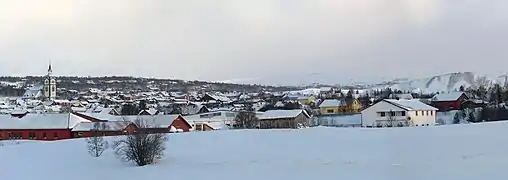 Overview Røros
Overview Røros Røros in summer
Røros in summer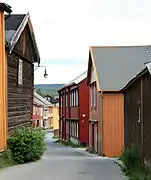 Finneveta, one of the narrow old streets in Røros
Finneveta, one of the narrow old streets in Røros- Røros filmed by WMNO Drone mai 2018
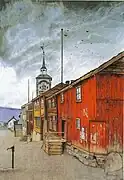 Fra Røros (Lillegaten), oil painting by Harald Sohlberg from 1902 (titled from Røros (side street))
Fra Røros (Lillegaten), oil painting by Harald Sohlberg from 1902 (titled from Røros (side street)) Storgaten Røros, painting by Harald Sohlberg from 1903 (titled Røros main street)
Storgaten Røros, painting by Harald Sohlberg from 1903 (titled Røros main street) Efter snestorm, Lillegaten Røros, oil painting by Harald Sohlbeg from 1904 (titled After the snowstorm, Røros sidestreet)
Efter snestorm, Lillegaten Røros, oil painting by Harald Sohlbeg from 1904 (titled After the snowstorm, Røros sidestreet)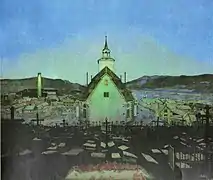 Natt painting by Harald Sohlberg from 1904 (titled Night)
Natt painting by Harald Sohlberg from 1904 (titled Night).jpg.webp) Malmplassen and Stangvekta
Malmplassen and Stangvekta.jpg.webp) Town of Røros and river Hitterelva
Town of Røros and river Hitterelva.jpg.webp) Town of Røros and Raubrua bridge
Town of Røros and Raubrua bridge.jpg.webp) Røros and Sleggveien
Røros and Sleggveien.jpg.webp) Røros and Bergstadens Ziir
Røros and Bergstadens Ziir.jpg.webp) Røros - Hyttklokka and Bergstadens Ziir
Røros - Hyttklokka and Bergstadens Ziir.jpg.webp) Røros in the autumn
Røros in the autumn
References
- ↑ "Navn på steder og personer: Innbyggjarnamn" (in Norwegian). Språkrådet.
- ↑ "Forskrift om målvedtak i kommunar og fylkeskommunar" (in Norwegian). Lovdata.no.
- ↑ Bolstad, Erik; Thorsnæs, Geir, eds. (26 January 2023). "Kommunenummer". Store norske leksikon (in Norwegian). Kunnskapsforlaget.
- 1 2 "Stadnamn og rettskriving" (in Norwegian). Kartverket. Retrieved 21 November 2023.
- ↑ "Røros - the mining town". Hurtigruten.us. Archived from the original on 7 February 2011. Retrieved 28 February 2011.
- ↑ Statistisk sentralbyrå. "Table: 06913: Population 1 January and population changes during the calendar year (M)" (in Norwegian).
- ↑ Statistisk sentralbyrå. "09280: Area of land and fresh water (km²) (M)" (in Norwegian).
- ↑ Jukvam, Dag (1999). "Historisk oversikt over endringer i kommune- og fylkesinndelingen" (PDF) (in Norwegian). Statistisk sentralbyrå.
- ↑ Rygh, Oluf (1901). Norske gaardnavne: Søndre Trondhjems amt (in Norwegian) (14 ed.). Kristiania, Norge: W. C. Fabritius & sønners bogtrikkeri. p. 199.
- ↑ "Fastsettelse av Rossen tjïelte som samisk navn på Røros kommune" (in Norwegian). LovData.no. 9 September 2022. Retrieved 21 November 2023.
- ↑ "Civic heraldry of Norway - Norske Kommunevåpen". Heraldry of the World. Retrieved 17 February 2023.
- ↑ "Røros kommune, våpen". Digitalarkivet (in Norwegian). Arkivverket. Retrieved 17 February 2023.
- ↑ "Kommunevåpenet på Røros". Bergstaden.org (in Norwegian). Retrieved 17 February 2023.
- ↑ "The People and the Farms". The Røros World Heritage Site.
- ↑ "The Røros Copper Works". The Røros World Heritage Site.
- ↑ "Rørosmartnan". Retrieved 25 February 2011.
- ↑ "Et historisk musikkteater på Røros" (in Norwegian). Retrieved 28 October 2008.
- ↑ "A Doll's House IMDB". IMDb.
- ↑ Hansen, Tore; Vabo, Signy Irene, eds. (20 September 2022). "kommunestyre". Store norske leksikon (in Norwegian). Kunnskapsforlaget. Retrieved 14 October 2022.
- ↑ "Kommunestyrevalg 2023 - Trøndelag Trööndelage". Valgdirektoratet. Retrieved 6 January 2024.
- ↑ "Tall for Norge: Kommunestyrevalg 2019 - Trøndelag". Valg Direktoratet. Retrieved 20 October 2019.
- 1 2 3 4 "Table: 04813: Members of the local councils, by party/electoral list at the Municipal Council election (M)" (in Norwegian). Statistics Norway.
- ↑ "Tall for Norge: Kommunestyrevalg 2011 - Sør-Trøndelag". Valg Direktoratet. Retrieved 20 October 2019.
- ↑ "Kommunestyrevalget 1995" (PDF) (in Norwegian). Oslo-Kongsvinger: Statistisk sentralbyrå. 1996. Retrieved 23 June 2020.
- ↑ "Kommunestyrevalget 1991" (PDF) (in Norwegian). Oslo-Kongsvinger: Statistisk sentralbyrå. 1993. Retrieved 23 June 2020.
- ↑ "Kommunestyrevalget 1987" (PDF) (in Norwegian). Oslo-Kongsvinger: Statistisk sentralbyrå. 1988. Retrieved 23 June 2020.
- ↑ "Kommunestyrevalget 1983" (PDF) (in Norwegian). Oslo-Kongsvinger: Statistisk sentralbyrå. 1984. Retrieved 23 June 2020.
- ↑ "Kommunestyrevalget 1979" (PDF) (in Norwegian). Oslo: Statistisk sentralbyrå. 1979. Retrieved 23 June 2020.
- ↑ "Kommunevalgene 1975" (PDF) (in Norwegian). Oslo: Statistisk sentralbyrå. 1977. Retrieved 23 June 2020.
- ↑ "Kommunevalgene 1972" (PDF) (in Norwegian). Oslo: Statistisk sentralbyrå. 1973. Retrieved 23 June 2020.
- ↑ "Kommunevalgene 1967" (PDF) (in Norwegian). Oslo: Statistisk sentralbyrå. 1967. Retrieved 23 June 2020.
- ↑ "Kommunevalgene 1963" (PDF) (in Norwegian). Oslo: Statistisk sentralbyrå. 1964. Retrieved 23 June 2020.
- ↑ Weather forecast for Haugan in Røros
- ↑ IMDb Database retrieved 02 September 2020
External links
- Municipal fact sheet from Statistics Norway (in Norwegian)
- History of Røros at Bergstaden.Org (in Norwegian)
- World heritage site Røros
- Røros info (in Norwegian)
- UNESCO Røros entry
- Visitnorway.com Røros
- Map hiking and DNT cabins
- VR images of Røros
- Haugan, Røros, Norway
